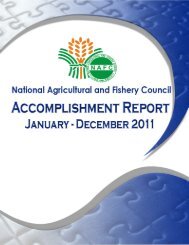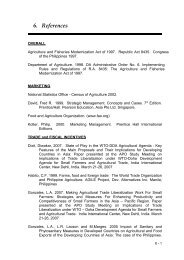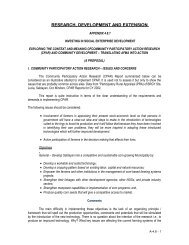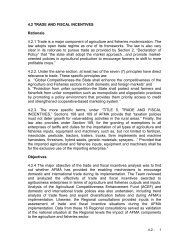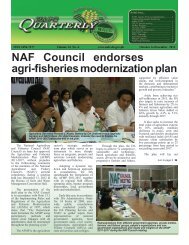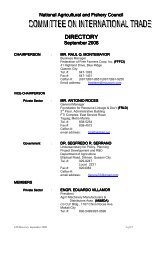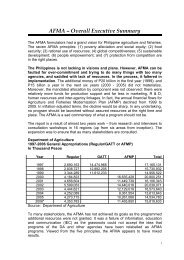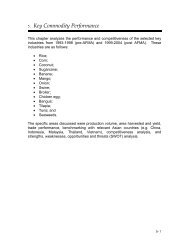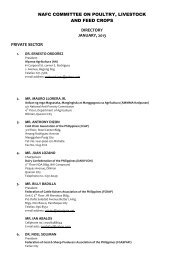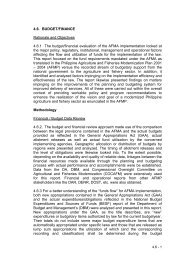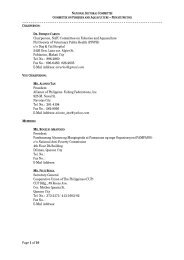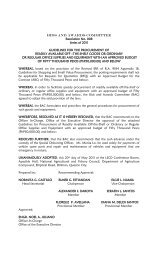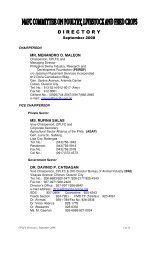NAFC-2nd Quarterly News letter2011 Final - National Agricultural ...
NAFC-2nd Quarterly News letter2011 Final - National Agricultural ...
NAFC-2nd Quarterly News letter2011 Final - National Agricultural ...
You also want an ePaper? Increase the reach of your titles
YUMPU automatically turns print PDFs into web optimized ePapers that Google loves.
Rubber Plantations<br />
in Luzon?<br />
Rubber is a tree crop usually associated<br />
in nearly typhoon-free Mindanao, so that<br />
when members of the <strong>NAFC</strong>’s industrial<br />
crop subcommittee of the Committee on<br />
Commercial Crops (CCC) learned that rubber<br />
trees are being farmed in Laguna and Quezon,<br />
they set out to investigate the phenomenon.<br />
Engr. Rolando Rosales, one of the subcommittee’s<br />
members and general manager<br />
of the First Laguna Rubber, shared this<br />
wonderful news to the group, and invited<br />
the members to see the areas.<br />
The sub-committee conducted the site<br />
validation last May 5 in Laguna and Quezon.<br />
The party consisted of representatives from<br />
the Traders Trust International, Latex<br />
Products, King’s Rubber, JDM Agroventures,<br />
CUP, Rubberfields, Inc., CocoaPhil and First<br />
Laguna Rubber, from the private sector<br />
side, and representatives from the Bureau of<br />
Plant Industry, Bureau of <strong>Agricultural</strong> Research,<br />
Bureau of <strong>Agricultural</strong> Statistics, and the <strong>NAFC</strong>.<br />
They learned that the First Laguna Rubber is a<br />
business enterprise that has been engaged in<br />
rubber propagation, planting and marketing<br />
since January 2006. The firm has successfully<br />
covered the provinces of Laguna, Quezon,<br />
Batangas, Cavite, Bulacan, Nueva Ecija, and<br />
the Cagayan Valley, with approximately<br />
700 hectares of rubber plantation.<br />
The party visited two rubber plantations in<br />
Laguna. The first site, located in Brgy.Ilayang,<br />
Butnog, Magdalena, is a five-hectare farm<br />
with 3,000 rubber trees. It was owned by<br />
Atty. Ceriaco Sumaya. The second site, in<br />
Brgy.Layugan, Pagsanjan, was a 2.5 hectare<br />
rubber farm with 2,500 mature rubber trees<br />
owned by Mr. Alex Pactananan.<br />
The rubber plantation visited in Quezon was<br />
a five-hectare farm with 5,000 mature trees,<br />
owned by former Councilor Ernida Reynoso.<br />
The plantations are intercropped with<br />
patola, squash, corn, coconut and cacao.<br />
Engr. Rosales emphasized that top pruning<br />
and double stocking methods are practiced<br />
in the farm to be able to resist typhoons<br />
and strong winds.<br />
First Laguna Rubber has started operating<br />
a rubber processing plant in Brgy. San Luis,<br />
Luisiana in Laguna, which was constructed<br />
and finished last September 2009. The mill<br />
processes rubber cup lumps up to five tons<br />
per day.<br />
4<br />
April to June 2011<br />
Grains post production group signs MOA with IRRI<br />
The Philippine Rice Post-Production<br />
Consortium (PRPC) recently entered<br />
into a partnership agreement with the<br />
International Rice Research Institute<br />
(IRRI) for the conduct of collaborative<br />
activities toward the enhancement of<br />
the grains postproduction systems<br />
in the country. The agreement was<br />
sealed during the PRPC’s Executive<br />
Committee meeting held June 9,2011<br />
at the <strong>NAFC</strong> Conference Hall where the<br />
PRPC presented to Secretary Proceso J.<br />
Alcala its accomplishments over the<br />
past two years. In his response, Sec.<br />
<strong>NAFC</strong> staff relearns gov’t bidding procedures<br />
Eight <strong>NAFC</strong> employees attended the<br />
Seminar/Workshop on The Philippine<br />
Bidding Documents and Updates on R.A.<br />
9184, otherwise known as the “Government<br />
Procurement Reform Act,” organized by the<br />
Association of Government Internal Auditors<br />
(AGIA) last April 27 to 29, 2011 at Hotel<br />
Kimberly in Malate, Manila. They joined 102<br />
participants from government agencies,<br />
local government units and universities<br />
nationwide. The three-day event focused<br />
Alcala proposed that the group conduct<br />
a workshop to identify possible PRPCassisted<br />
interventions that will contribute<br />
to the successful implementation of<br />
the DA’s Rice Self-Sufficiency Program.<br />
Picture above shows representatives of<br />
the partners signing the memorandum of<br />
agreement for the partnership: from left,<br />
William Padolina, IRRI’s Deputy Director,<br />
Secretary Alcala and <strong>NAFC</strong> OIC-Director<br />
Noel Juliano. During the same meeting,<br />
the PRPC members decided to change<br />
the group’s name to Philippine Grains<br />
Postproduction Consortium (PGPC).<br />
on the Philippine Bidding Documents for<br />
the Procurement of Consulting Services,<br />
Goods/Services and Infrastructure Projects.<br />
Seated from left to right in above photo are:<br />
Carmelo Yambao, Shirley Pascua, Serafin<br />
Santos, Diana de los Santos, Carmencita<br />
Begonia, Agapita Agustin, Ceniza Dacumos,<br />
Normita Castillo, and one of the lecturers,<br />
Engr. Angelito Z. Saliendra, State Auditor<br />
V from the Technical Services Office of the<br />
Commission on Audit.



